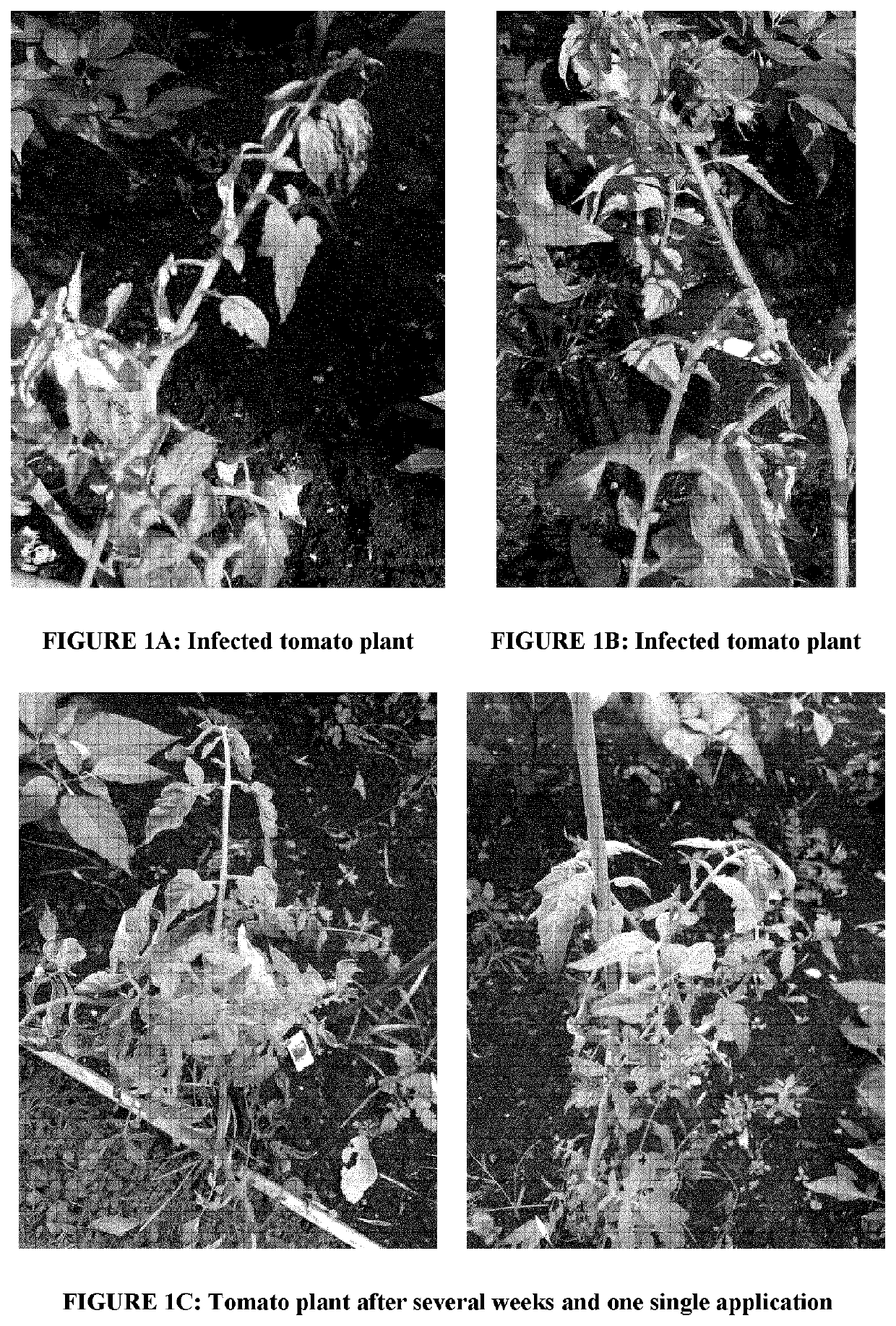Herbal compositions and methods for the prevention and treatment of plant of nail infections
a technology for nail infections and herbal compositions, applied in the direction of biocide, plant/algae/fungi/lichens ingredients, antibacterial agents, etc., can solve the problems of plant injury, difficult penetration of most water-based spray solutions, and insufficient formulation of pesticide formulations, etc., to achieve the effect of increasing crop yield
- Summary
- Abstract
- Description
- Claims
- Application Information
AI Technical Summary
Benefits of technology
Problems solved by technology
Method used
Image
Examples
example 1
ray of Tomato Plants Infected with Blight Fungus
[0108]Passalora fulva (Cladosporium fulvum) causes tomato leaf mould. Foliage is often the only part of the plant infected and causes infected leaves to wither and die, indirectly affecting yield. In severe cases, blossoms and fruit can also be infected directly reducing yield.
[0109]Treatment of infected tomato plants has been done on Day 1, 3 and 5 with foliar spray comprising an aqueous 1:10 (1 part root to 10 parts water) extract of Chelidonium majus root with 0.25% of a surfactant such as polysorbate 20.
[0110]As shown by comparing the pictures presented in FIGS. 1A and 1B and in FIG. 1C, single foliar application to tomato plants shows effective recovery from infection after several days and one single application. Field study demonstrated that the infection did not spread to adjacent uninfected plants and that growth was evidence post-treatment in the affected plants.
example 2
ray of Tomato Plants Infected with Powdery Mildew
[0111]Powdery mildew is a disease of leaf tissue (see FIG. 2A). Yield and fruit quality are reduced because the disease develops quickly, and severely affected leaves are killed. This results in less fruit being produced.
[0112]Treatment of infected tomato plants has been done on Day 1 and 3 with foliar spray comprising 1% of an aqueous 10:1 (10 part root to 1 parts water-ethanol) extract of Chelidonium majus root, 1% thymol with 0.25% of a surfactant such as polysorbate 20. Two sprays to end-of-season hydroponic tomato plants, heavily infected with powdery mildew, resulted in significant improvement in comparison to unsprayed plants (See FIG. 2B). Spore load was clearly reduced on all leaves, and cleared from young leaves. The latter is particularly important since plants were able to continue to grow to support late-season fruit load.
example 3
s of Cucurbits Infected with Mildew Fungus
[0113]FIGS. 3A and 3B shows the results of a twice a day application over 3 days of a foliar spray comprising an aqueous 1:10 (1 part root to 10 parts water) extract of Chelidonium majus root with no surfactant.
[0114]As a result of this test, is noted plant's vigor and health are regained; plants flower and produced crop again. Fungi has first browned and then died. 14 days post last treatment one of the infected leaves is still alive with green zones. If the fungus infection had survived the leaf would have died and browned completely.
[0115]FIGS. 4A to 4C shows the results of a twice a day application over 3 days of a foliar spray comprising an aqueous 1:10 (1 part root to 10 parts water) extract of Chelidonium majus root with 0.25% of a surfactant (polysorbate 20).
[0116]As a result of this test, is noted plant's vigor and health are regained; plants flower and produced crop again with a nice shining green color of the leaves. Fungi has fir...
PUM
| Property | Measurement | Unit |
|---|---|---|
| wt % | aaaaa | aaaaa |
| wt. % | aaaaa | aaaaa |
| volume | aaaaa | aaaaa |
Abstract
Description
Claims
Application Information
 Login to View More
Login to View More - R&D
- Intellectual Property
- Life Sciences
- Materials
- Tech Scout
- Unparalleled Data Quality
- Higher Quality Content
- 60% Fewer Hallucinations
Browse by: Latest US Patents, China's latest patents, Technical Efficacy Thesaurus, Application Domain, Technology Topic, Popular Technical Reports.
© 2025 PatSnap. All rights reserved.Legal|Privacy policy|Modern Slavery Act Transparency Statement|Sitemap|About US| Contact US: help@patsnap.com



